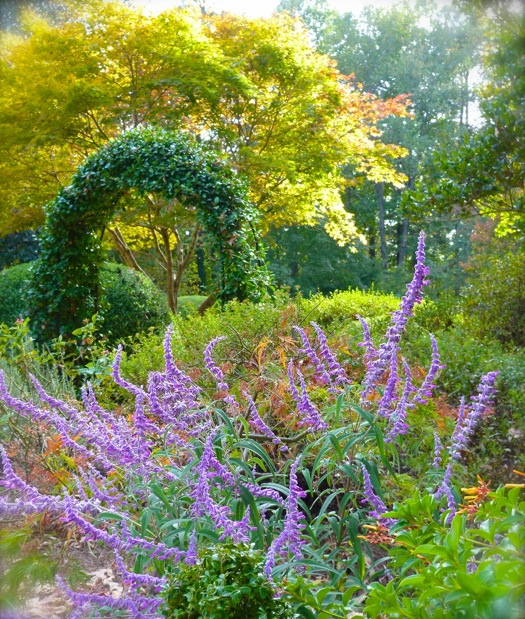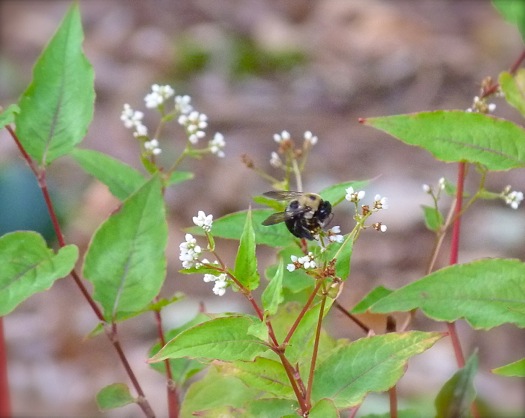Bee Friendly
 Sunday, October 16, 2016 at 4:40PM
Sunday, October 16, 2016 at 4:40PM I have been seeing a variety of bees in the garden lately, including honey bees, carpenter bees and others. Carpenter bees are especially attracted to several fall-flowering plants next to our patio. Every day I see them buzzing around the Mexican Sage (Salvia leucantha), Red Dragon Persicaria, and Caryopteris 'Jason'. Mexican Sage
Mexican Sage  Mexican sage attracts hummingbirds, bees and butterflies. It blooms summer through fall and is hardy to about 15 degrees F.
Mexican sage attracts hummingbirds, bees and butterflies. It blooms summer through fall and is hardy to about 15 degrees F.
 Here is a view of the front garden, looking over the Mexican sage by the patio. The Japanese maple behind the arch is the one attacked by Ambrosia Beetles. I have treated it and removed much of the affected areas. I will wait till spring to see if it survives. Despite the extensive surgery, it is still a beautiful tree.
Here is a view of the front garden, looking over the Mexican sage by the patio. The Japanese maple behind the arch is the one attacked by Ambrosia Beetles. I have treated it and removed much of the affected areas. I will wait till spring to see if it survives. Despite the extensive surgery, it is still a beautiful tree.  A close-up of Mexican Sage; it feels like velvet!
A close-up of Mexican Sage; it feels like velvet!
 Here is another view of Mexican Sage.
Here is another view of Mexican Sage.
 The Mexican Sage coordinates well with this birdhouse. The orange flowers are Firebush, another great plant that attracts hummingbirds, bees and butterflies.
The Mexican Sage coordinates well with this birdhouse. The orange flowers are Firebush, another great plant that attracts hummingbirds, bees and butterflies.
 The pollinators also love Red Dragon Persicaria.
The pollinators also love Red Dragon Persicaria.


 Fall-blooming Caryopteris is also called Blue Mist Shrub or Bluebeard. Be aware there is a spirea called Blue Mist Shrub, which is a different plant!
Fall-blooming Caryopteris is also called Blue Mist Shrub or Bluebeard. Be aware there is a spirea called Blue Mist Shrub, which is a different plant!
Carpenter bees look much like bumblebees in size and appearance, but the top of their abdomens are hairless and shiny black, while bumblebees are fully clothed with hairs, many of them yellow. 
 Carpenter bees are important pollinators and they don't sting you, but they are noted for drilling holes into wooden structures, which they use for nesting and overwintering. They also use trees or telephone poles.
Carpenter bees are important pollinators and they don't sting you, but they are noted for drilling holes into wooden structures, which they use for nesting and overwintering. They also use trees or telephone poles.
Although we have a healthy carpenter bee population around our home, I have never seen any evidence of damage from them. (We do have problems with woodpeckers, who mistake the stucco on the front of our house for dead trees!) Carpenter bees prefer unpainted or old, weathered wood, so the best way to prevent damage to your home is to paint or varnish any wooden structures. Simply staining the wood does not usually work. There also are both chemical and organic products available to get rid of carpenter bees.
Before you decide to kill them, remember that, unlike honey bees, carpenter bees are native to America and they pollinate many types of blooms. A lot of bee species are on the decline due to disease and insecticide use. Without our pollinators, we won't have beautiful gardens or food!
Reader Comments (14)
Hi Deb, it always feels good to see bees in the yard, doesn't it? I love the Mexican Sage in your garden. The lavender color is so beautiful to have in autumn and I can imagine that the blooms make nice bouquets for the house at this time of the year as well.
Mexican Sage is a plant that does grow well in my area and your post has encouraged me to get a plant or two and bring some bee food and beautiful lavender blooms into my garden, too.
Wishing you a wonderful autumn!
Warm regards,
Christina
I love this post! Carpenter bees are awesome. They adore our passion vine blooms, often falling asleep on them. You have such a beautiful garden Deb. Every time I see the long shots you post from around your garden I just want to come over and sit and enjoy your surroundings.
It's such a joy to see the bees at work in the garden, isn't it? I'm not seeing as many bees here anymore, so many have probably started their hibernation or passed on. Your fluffy Mexican Sage is a beautiful color and the texture looks so soft and smooth.
Wonderful bee photos, Deb! Thanks for clarifying the difference between bumble and carpenter bees too. I wish Salvia leucantha did as well in my garden as it does in yours. It SHOULD do well here but it hasn't for reasons I haven't determined. I was glad to see the fall color on your injured Japanese maple too - I hope it comes through its current trial.
Like you, we have an abundance of Carpenter bees too with no structure damage. I always wonder where they live? I never remember seeing that particular front view before with the arch. It is a beautiful vignette. Your bee photos are wonderful. Two thumbs up for bees!
Such wonderful bee shots! I particularly like the birdhouse/Mexican sage combi - absolutely lovely! I adore seeing bees in the garden. Spotting the first one after winter - usually a bumblebee - is something I look forward to every year. They are beautiful and fascinating creatures. I am now going to scroll back up this post and enjoy these photos again.
Your Mexican Sage is so pretty! I wish it was perennial up here. I love seeing bees in the garden! I don't see as many carpenter bees up here, but my parents who live down South had a long struggle with carpenter bees drilling into their older house that they used to live in.
I would never kill Carpenter Bees. Salvias of all sorts are great for bees, and hummingbirds, too! Excellent photographs, by the way!
Oh those Carpenter bees. We have more of them than any other. Sage is always a must in the garden...seems to make everyone happy.
I see our carpenter bees on the Septemberbossie.
Must take time to see if they also enjoy the Mexican sage.
Delightful post! I got stung by bees many times when I was a child, but I never stopped loving them. I don't see carpenter bees in my garden, but they are welcome!
Really nice photos Deb! I see lots of carpenter bees around my house, and I just leave them be. I don't see any damage to the house, for now.
Loads of carpenter bees here too and I've never noticed any damage to the house or deck either.
(At my parents' house in Pennsylvania, they did drill holes in an old porch years ago.)
The carpenter bees (and other bees) seem to love the Vitex agnus-castus the most here.
I grew Mexican bush sage last year and was very impressed by it around this time of year, but it did not return after a relatively mild winter (lows ~ 12 F a couple of times). I guess as you say it's only hardy to 15 F or so.
Other blooms here still attracting bees and butterflies include some surviving zinnias and some nice patches of blue mistflower. The Caryopteris seems to be pretty much finished blooming here ... perhaps because it's been so dry and I was off on vacation and couldn't water. Have you been irrigating yours or have you gotten more rain than we've had? (We're in moderate drought here now, though it's much, much worse in Chattanooga...)
Hi, everyone, and thank you for your comments! Each is important to me. Aaron, we are in severe drought. We are trying to keep important things watered. Best wishes, and may rain come soon for you and me both! Deb